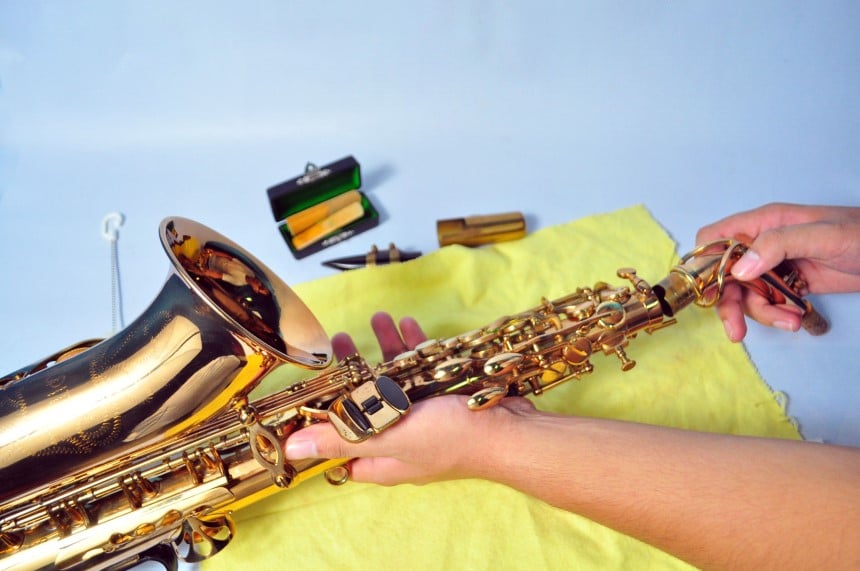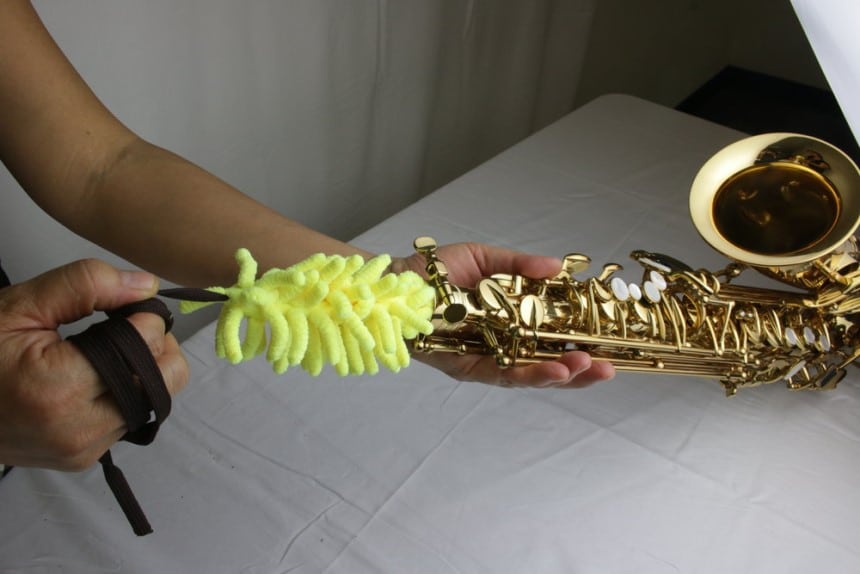For aspiring sax players, the idea of cleaning isn’t the most exciting aspect of their new instrument. It’s not why any of us get into playing instruments but knowing how to clean a saxophone is an essential part of getting to grips with your new instrument.
This isn’t just about keeping your sax looking great, either. A saxophone that isn’t cleaned and looked after may not last as long. On top of that, it can become a hotbed for bacteria which can even make you ill. Your mouth is constantly coming into contact with the sax, so you don’t want to take in bacteria as a result. So it’s easy to see why there are so many reasons to get to grips with cleaning your sax and doing a thorough job.
There are some aspects of cleaning that boil down to personal preference. If you’re thinking about how often to shine the outside of your sax then people all have their own routines. However, some aspects of saxophone cleaning need to be done regularly. To keep the reed and the mouthpiece clean, most people recommend that the cleaning takes place at least once a week. If you leave your sax for more than a week before playing it, you should clean it before playing it again.
It’s a good idea to have a rough understanding of the different parts of the sax. Knowing how to clean the mouthpiece and the reed is very important, but that doesn’t mean the other parts aren’t. The keys are where you interact with the saxophone, using your hands to compress them. These are situated along the stack, which is split into the upper stack and lower stack. The bell is the horn-shaped part where the sound is amplified.
There are some other parts, but these are the main aspects of the anatomy of a sax. Each model can vary, for example, an alto sax will be far smaller than a baritone model.
Deep cleaning a saxophone is a similar process for the majority of types of sax, from tenor to alto to baritone and beyond. There are some subtle differences based on what style of sax you are playing. A lot of people start their saxophone journey with a model like the Yamaha YAS-280, which is a relatively simple model to clean due to the conventional design. The half-bell shape is easier to clean than smaller models which do not have a bell. The reed and mouthpiece are the same for each of the types of model.
Make sure you are cautious when you start to clean your sax. Knowing how to deep clean a saxophone is different to knowing how to clean the outside of the saxophone as this can damage the interiors, or your cleaning substances might even be able to get into your system if you aren’t careful.
 What you’ll need
What you’ll needIf you want to easily ensure that you have all of the materials you need for cleaning then the Cecilio Maintenance Kit is a great way to get everything in one product and not have to worry that you’ve forgotten anything. You need a Polishing Cloth to wipe the sax, Cork Grease, which is used for instruments like saxophone and trombone, and a brush to reach down into the mouthpiece. A specific mouthpiece brush should be purchased for this.
It’s a good idea to have a sink and water supply, some rags or towels, and a mild soap. Depending on what areas you want to clean, and the materials your instrument is made out of, you could also use something like hydrogen peroxide for some intense cleaning of the saxophone reeds.
Mold Trusted Source Mold - Wikipedia A mold is a fungus that grows in the form of multicellular filaments called hyphae. en.wikipedia.org is incredibly dangerous and hard to get rid of on your sax. We recommend that rather than clean mold out of a saxophone, you take it to a music store and replace the parts. The cork on the bell of the sax, and the reed, are both susceptible to mold. They’re relatively cheap and easy to replace. You don’t want to take any chances.

For the neck of the instrument, you can even run water through, or soak it in vinegar to remove much of the bacteria.
It’s important to know how to clean the saxophone mouthpiece. You can use a cloth and warm water with a mild soap or detergent. This will help to kill off potentially harmful bacteria. There is no problem submerging or rinsing the mouthpiece with water and even with mild cleaning products.
A lot of people want to know how to clean a saxophone mouthpiece with vinegar. Vinegar can cleanse without causing any issue with the metal. Use a soft toothbrush and soak it in vinegar before rubbing around the mouthpiece for a deep clean.
Reeds aren’t too expensive, so if there is any mold on your reeds then it is a good idea to get new ones. However, you can disinfect these by soaking in water and soap. Some people also use hydrogen peroxide to kill off any potential bacteria. The process of how to clean a reed in a saxophone is so simple, you just need to leave them in the solution for 30 minutes.
A silver saxophone allows you to use metal polish with now problems. All you need is a little polish and a soft cloth. Rub a tiny, thin coat of polish into the instrument and buff. This can take quite a while, but the results usually end up with a sax that looks far better. If you are looking for how to clean an alto sax, make sure it has silver metal construction before you use metal polish.
If you play your sax a lot, you’ll need to know how to clean a saxophone neck strap, too. These can be very useful but they can also get smelly over time as sweat and grime builds up on them. Most straps can be rinsed in soapy water, but make sure you check the materials. If it is leather, then you might just have to soak in water to remove some of the bacteria. There are specific leather cleaning solutions you can buy, too.
The outside of a saxophone isn’t as much of a worry when it comes to the harmful bacteria, but you still want to rub and polish the sax. You will also want to pay close attention to the area around the keys as this can get clogged up and even cause them to become hard to play over time as grime builds up in the holes.
It’s a good idea to wipe down the instrument after every use, you don’t know what bacteria has become lodged in the instrument, and you don’t want to leave it to fester in the case for a long time as this can allow bacteria to spread or damage your instrument.
It’s worth doing some research based on the specific type of saxophone you need to clean. The mainstream sizes such as alto and tenor follow a very similar cleaning pattern, but if you have something like a specialist sopranino instrument it might not be so simple.
A lot of people who buy a saxophone for the first time don’t realize that the cleaning is not just about keeping the instrument looking good. Sure, knowing how to clean a saxophone on the outside to provide it with a good, clean look is important, but it is nowhere near as vital as knowing how to clean the inside of your saxophone.
It’s easy to follow many of the steps to clean a saxophone, and doing so can help you to avoid long-term issues including bacteria building up. This can even make you unwell! Inhaling bacteria is never a good idea, so keeping your sax clean is a vital step, even if it can feel a little boring.





